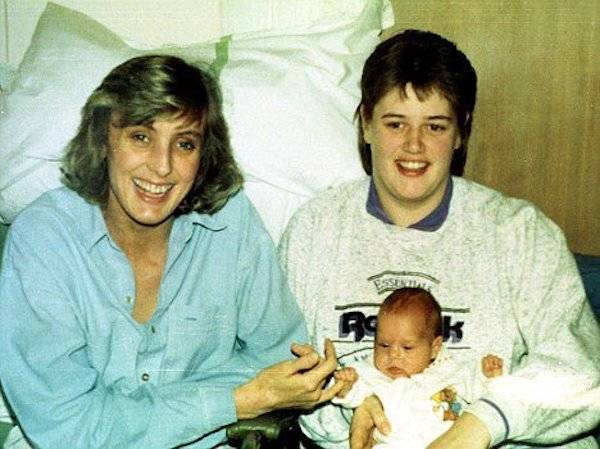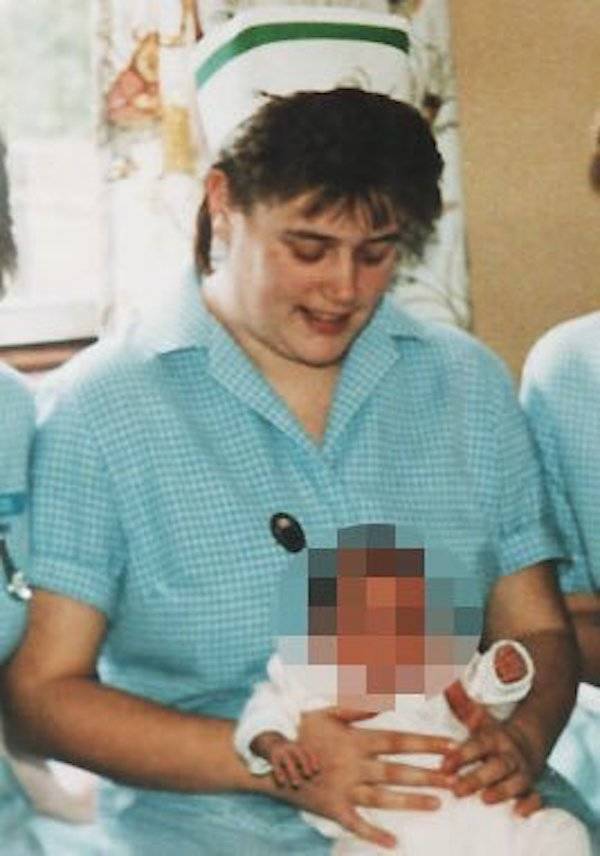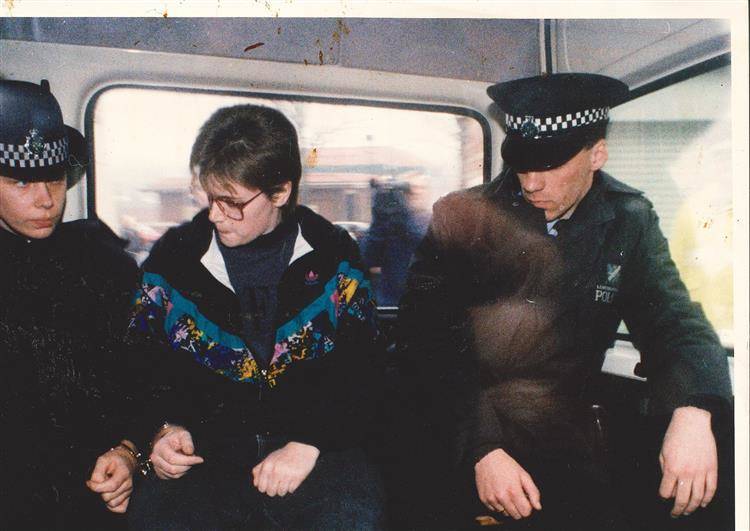Beverley Allitt, also known as the "Angel of Death," killed several children under her care. Her Munchhausen's by Proxy syndrome had gotten out of hand, right as she became a nurse.

TwitterBeverley Allitt, seemingly harmless, and smiling.
Murder has been an inherent human fear ever since our ancestors could wield rocks and sticks well enough to commit the heinous act. Serial killers are even scarier due to the relentless carnage of their patterns and the unpredictability of their evil presence. Even more terrifying are serial child killers — let alone those who happen to work as caretakers for small, defenseless kids.
Beverley Allitt belonged to the latter category. Working as a State Enrolled nurse in the children’s ward of the Grantham and Kesteven Hospital in Lincolnshire, England, this nurse was convicted of murdering four children, attempting to kill three others, and causing grievous bodily harm to six more.
According to Biography, Allitt’s killing spree took place across 59 days, spanning from winter to springs of 1991. Her methods made these atrocities even more grisly — she preferred to inject large quantities of insulin, or simply syringe-derived air bubbles into her underage victims.

Wikimedia CommonsThe Grantham and Kesteven Hospital where Allitt began killing.
In May 1993, Allitt was sentenced by the Nottingham Crown Court. She received thirteen life sentences, and was told by Justice Latham that she posed “a serious danger” to others, unless she was forcibly removed from society.
Allitt — one of Britain’s most infamous serial killers and known as the “Angel of Death” — remains behind bars to this day, at Rampton Secure Hospital in Nottinghamshire.
As the perpetrator of these crimes has surely done herself, an exploration of her past deeds and their potential origins seems in order.
From Childhood To Child Killer
Beverley Gail Allitt was born on Oct. 4, 1968 in Grantham, Lincolnshire, England. Even at an early age, she displayed some disconcerting behaviors that would eventually be clarified by a Munchausen’s syndrome diagnosis.
Allitt would unnecessarily bandage non-existent wounds and use casts to protect injuries she never sustained. Her adolescence included dramatic weight gain, and refinement of attention-seeking mannerisms and behaviors. Allitt became noticeably aggressive toward others.
Throughout her youth, the teen sought attention from doctors in various hospitals. One time, she actually got what she bargained for — and had her appendix removed, which, by all accounts, was entirely healthy and functioning as it should.
The healing process was impeded throughout, as Allitt was seemingly incapable of not fidgeting with the surgical scar. She practiced this kind of self-harm, in general, and eventually had to switch doctors on a routine basis to avoid being diagnosed as potentially unfit.
The most commonly accepted theory surrounding Allitt’s mental evolution during this period was that her Munchausen’s syndrome remained continuously incomplete. When she didn’t receive the attention she desperately sought from others, her self-harm began to be redirected toward others.
Unfortunately, this was right around the time Allitt decided to become a nurse.
Beverley Allitt Becomes A Nurse
During her training to become a nurse, Allitt’s abnormal behavior began to arise some warranted suspicion. She would smear stool on nursing home walls — when she wasn’t absent from her strict training schedule, that is. Her explanations varied, but were always the same — she was sick.
Allitt actually managed to nurture a romantic relationship at this time. While her boyfriend was blissfully ignorant to her behavior at work, however, he soon discovered Allitt’s unhinged tendencies after hours. He later revealed she was often aggressive, deceptive, and manipulative.
He also said Allitt accused him of rape. That she was pregnant. The relationship ended shortly after.

TwitterAllitt, with one of her victims, and the victim’s mother.
Miraculously, Allitt’s demented habit of smearing feces across the walls and not attending her training as required didn’t prevent her from professional success. She’d failed her examinations numerous times — but was offered a six-month contract at the Grantham and Kesteven Hospital in Lincolnshire in 1991.
The facility had long been understaffed, which potentially explained her employment there. Allitt was designated to work in Children’s Ward 4. With only two other trained nurses on staff in that part of the hospital — one during the day shift, one for night shifts — Allitt’s despicable violence toward children went undiscovered for a long, long time.
Beverley Allitt Begins Killing
Allitt murdered her first victim on Feb. 21, 1991. When seven-month-old Liam Taylor was admitted to her ward with a chest infection, Allitt assured his parents he as in safe hands and gently urged them to go home. When they returned, Allitt explained that the child experienced a breathing emergency, but was stable now.
The following night, Liam had another respiratory emergency. The staff was confident he’d handle it without a hitch — but Allitt looked over him, and his condition quickly worsened. The boy became pale, and red splotches covering his face. Liam suffered cardiac arrest shortly after.
He survived via life-support equipment, but had already suffered extensive brain damage. The parents decided to pull the plug — an agonizing decision, likely brought on by Allitt’s secretive activities.

TwitterBeverley Allitt, working at Grantham and Kesteven Hospital.
Two weeks later, 11-year-old cerebral palsy patient Timothy Hardwick was transferred to Ward 4 after he suffered an epileptic fit. Allitt was in charge of his wellbeing. Once again, her patient experienced a respiratory issue. He was found without a pulse, turning blue — and couldn’t be saved.
One-year-old Kayley Desmond was Allitt’s third victim. The young girl was transferred to Ward 4 on March 3, 1991, with a chest infection. Though she seemed to be recovering splendidly, Kayley went into cardiac arrest five days later — while Allitt was taking care of her.
Kayley was successfully revived, and transferred to a different hospital nearby, however. This is where physicians discovered first signs of foul play — a puncture wound under her armpit, and an adjacent air bubble. Unfortunately, this was analyzed as an accidental injection, allowing Allitt to retain her shroud of secrecy.

The courts were heavily criticized for allowing Allitt to enjoy relative freedom while incarcerated.
Paul Crampton, a five-month-old patient with a bronchial infection, became Allitt’s fourth victim. He suffered an insulin shock on March 20, 1991, and was on the verge of going into a coma three separate times. He was revived each time, but doctors were bewildered by his high insulin levels
Allitt rode to another Nottingham hospital with him. Upon arrival, his levels were once again severely abnormal. He fortunately survived. Five-year-old Bradley Gibson became her next victim. Suffering from pneumonia, he went into cardiac arrest, but was successfully resuscitated — with high insulin levels, which once again confused doctors.
Allitt tended to him that night, when he suddenly had another heart attack. He was transported to another hospital, and recovered well. Even though all of these incidents had one common factor — Allitt’s presence and suppose care — nobody seemed to notice, or consider the grisly possibilities.
Two-year-old Yik Hung Chan turned blue on March 22, 1991, but was saved by induced oxygen. He had a second attack which resulted in a fortunate transfer, which allowed him to recover. Katie and Becky Phillips — two 2-month-old twins — were kept for observation after premature birth.
Allitt tended to Becky when she suffered from gastroenteritis on April 1, 1991. Two days later, Allitt said Becky could be hypoglycemic, and possibly cold to the touch — but nothing of note was assessed. The infant was sent home to her mother. That night, she convulsed, cried out, and died.
Katie, meanwhile, was still under Allitt’s care. Once more, respiratory issues occurred. While resuscitation was successful, the girl experienced the same emergency two days later. Her lungs collapsed. She was transferred to Nottingham, where it was discovered that five of her ribs were broken, and that she had severe brain damage.
In a nearly inconceivable turn of events, Katie’s mother was so thankful to Allitt for supposedly saving her daughter’s life that she asked the “Angel of Death” to become Katie’s godmother. She accepted — even after causing partial paralysis, cerebral palsy, and sight and hearing damage.
Capture And Trial
After four further inexplicable incidents on largely healthy patients occurred — people finally began to suspect Allitt of foul play. When 15-month-old Claire Peck died from a heart attack on April 22, 1991, the jig was nearly up. The autopsy pointed toward natural causes, but Dr. Nelson Porter, concerned by the high rates of strange deaths in the past two months, launched an official inquiry.
Eighteen days later, tests uncovered abnormal levels of potassium in Claire’s blood, resulting in the police being called. The girl was exhumed, and Lignocaine — a substance used to help adults during cardiac arrests — was found in her system. The police superintendent subsequently assigned Stuart Clifton to investigate what was clearly a series of purposeful crimes.
Clifton examined the other strange incidents, and found a clear commonality — high levels of insulin. He then discovered that Allitt had previously reported that the key to the insulin fridge had gone missing. The nursing logs of dates covering 25 suspicious incidents, too, were gone.

Beverley Allitt, finally under arrest. 1993.
The policeman quickly realized that Allitt was his prime suspect, and by July of 1991, the department was confident it had enough solid evidence to charge her with murder. Nonetheless, they waited until November to avoid any irrevocable investigative missteps.
Allitt appeared fairly at ease during interrogations. She denied everything, and stood firm in her claims she’d merely tried to help those kids. When police searched her home, they discovered some of the missing nursing logs.
They then looked into her past, and began to realize she might’ve been suffering from a serious personality disorder for years. Her Munchausen’s by Proxy — inflicting pain on others to garner attention — was finally a realized motive.
Allitt refused to admit to what she had done, even after numerous visits and assessments by psychologists while already incarcerated. She was charged with four counts of murder, 11 counts of attempted murder, and 11 counts of causing grievous bodily harm.
Allitt lost a tremendous amount of weight while awaiting trial. Her anorexia saw her shed 70 pounds. These illnesses caused a delay in her trial, which was eventually held at Nottingham Crown Court. On Feb. 15, 1993, prosecutors proved that she had been present during each abnormal incident.
All recorded evidence of high levels of insulin, potassium, and various injections and puncture marks were presented to the court. She was also formally accused of preventing oxygen flow to some of the victims — by smothering, or, alternatively, affecting the medical equipment.
The trial also covered her childhood, with pediatrics expert Prof. Roy Meadow testifying to Munchausen’s syndrome, and Munchausen’s by Proxy syndrome’s symptoms being extremely evident in Allitt. He also pointed to her behavior upon arrest, the amount of illnesses plaguing her life, and subsequent delay of the trail as evidence of this diagnosis.
Prof. Meadows admitted that he believed Allitt would never be cured of her condition. It had simply developed and established itself for too long — she had to be removed from society protect others. The trial lasted for two months. Allitt attended it for 16 days, because she was sick.
On May 23, 1993, she was hit with 13 life sentences, for murder and attempted murder. It marked the most years ever doled out to a female. Justice Latham, however, said it was a righteous punishment for the horrific cruelties she had displayed — and her cynical decision to become a nurse.
The Aftermath Of Beverley Allitt’s Crimes
The legacy Beverley Allitt left behind was so strong and pervasive that the Maternity Unit at Grantham and Kesteven Hospital was shut down — for good. As for Allitt, herself, the murderer was sent to Rampton Secure Hospital, rather than a traditional prison.
Britain’s Mental Health Act designated this high-security facility, among others, for criminals like Allitt. She resumed her attention-seeking habits soon enough. Allitt swallowed glass on one occasion and poured boiling water on her hand on another.
‘I’ve done quite a few things like this in my time, but I’ve never quite seen anything quite like it.’
Broadcasting legend Sir Trevor McDonald talks about his new Crime & Punishment documentary looking at the case of killer nurse Beverley Allitt. pic.twitter.com/4BJS6QMqBV
— Good Morning Britain (@GMB) October 22, 2018
Since then, she finally admitted to three of the murders, and six of the assaults. The U.K.’s Home Office officially categorized Allitt as one of the few criminals who would never be eligible for parole, due to the simple gravity of her crimes.
During her life as a prisoner, the father of her first victim, Liam, Chris Taylor has publicly denounced Rampton as a sham. Taylor claimed the facility is mere daycare for people who should be treated as serious criminals.
To his point, the facility has around 1,400 employees — and 400 inmates. In May, 2005, The Mirror reported that Allitt received over $40,000 in State benefits since she was imprisoned in 1993. In 2006, Allitt applied for review. The Probation Service subsequently contacted the families of her victims — as of yet, Allitt is still behind bars.
After learning about the heinous crimes of nurse and serial killer Beverley Allitt, check out 21 serial killer quotes that will chill you to the bone. Then, learn about Pedro Rodrigues Filho, Brazil’s real-life “Dexter,” and the mother-murdering teen Gypsy Rose Blanchard.





